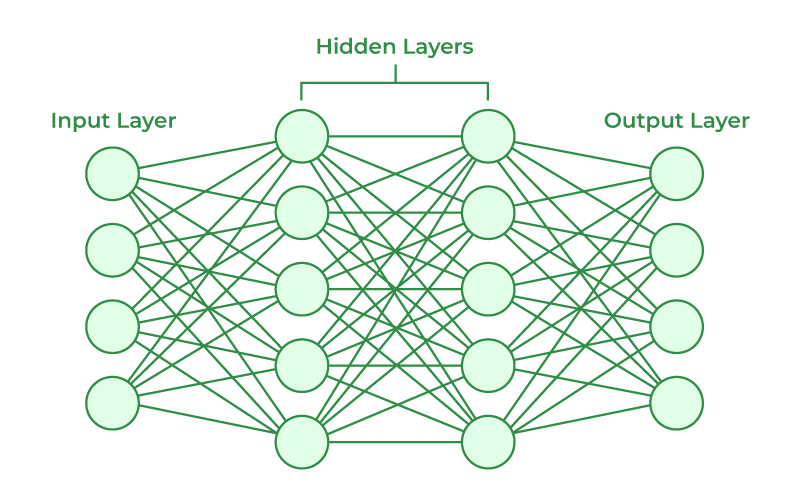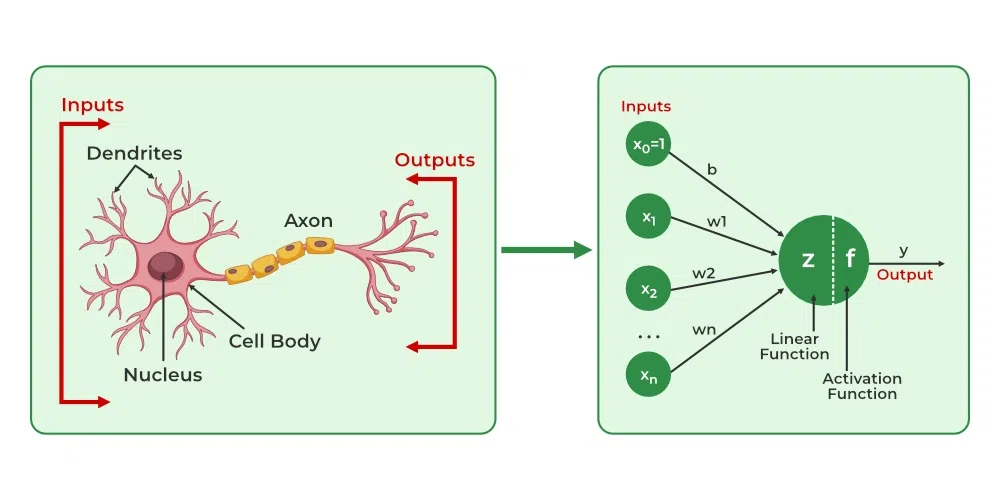Artificial Neural Networks and its Applications
Last Updated :
07 Aug, 2024
As you read this article, which organ in your body is thinking about it? It’s the brain of course! But do you know how the brain works? Well, it has neurons or nerve cells that are the primary units of both the brain and the nervous system. These neurons receive sensory input from the outside world which they process and then provide the output which might act as the input to the next neuron.
Each of these neurons is connected to other neurons in complex arrangements at synapses. Now, are you wondering how this is related to Artificial Neural Networks ? Let’s check out what they are in detail and how they learn information.
Artificial Neural Networks
Artificial Neural Networks contain artificial neurons which are called units . These units are arranged in a series of layers that together constitute the whole Artificial Neural Network in a system. A layer can have only a dozen units or millions of units as this depends on how the complex neural networks will be required to learn the hidden patterns in the dataset. Commonly, Artificial Neural Network has an input layer, an output layer as well as hidden layers. The input layer receives data from the outside world which the neural network needs to analyze or learn about. Then this data passes through one or multiple hidden layers that transform the input into data that is valuable for the output layer. Finally, the output layer provides an output in the form of a response of the Artificial Neural Networks to input data provided.
In the majority of neural networks, units are interconnected from one layer to another. Each of these connections has weights that determine the influence of one unit on another unit. As the data transfers from one unit to another, the neural network learns more and more about the data which eventually results in an output from the output layer.

Neural Networks Architecture
The structures and operations of human neurons serve as the basis for artificial neural networks. It is also known as neural networks or neural nets. The input layer of an artificial neural network is the first layer, and it receives input from external sources and releases it to the hidden layer, which is the second layer. In the hidden layer, each neuron receives input from the previous layer neurons, computes the weighted sum, and sends it to the neurons in the next layer. These connections are weighted means effects of the inputs from the previous layer are optimized more or less by assigning different-different weights to each input and it is adjusted during the training process by optimizing these weights for improved model performance.
Artificial neurons vs Biological neurons
The concept of artificial neural networks comes from biological neurons found in animal brains So they share a lot of similarities in structure and function wise.
- Structure : The structure of artificial neural networks is inspired by biological neurons. A biological neuron has a cell body or soma to process the impulses, dendrites to receive them, and an axon that transfers them to other neurons. The input nodes of artificial neural networks receive input signals, the hidden layer nodes compute these input signals, and the output layer nodes compute the final output by processing the hidden layer’s results using activation functions.
|
Biological Neuron
|
Artificial Neuron
|
|
Dendrite
|
Inputs
|
|
Cell nucleus or Soma
|
Nodes
|
|
Synapses
|
Weights
|
|
Axon
|
Output
|
- Synapses : Synapses are the links between biological neurons that enable the transmission of impulses from dendrites to the cell body. Synapses are the weights that join the one-layer nodes to the next-layer nodes in artificial neurons. The strength of the links is determined by the weight value.
- Learning : In biological neurons, learning happens in the cell body nucleus or soma, which has a nucleus that helps to process the impulses. An action potential is produced and travels through the axons if the impulses are powerful enough to reach the threshold. This becomes possible by synaptic plasticity, which represents the ability of synapses to become stronger or weaker over time in reaction to changes in their activity. In artificial neural networks, backpropagation is a technique used for learning, which adjusts the weights between nodes according to the error or differences between predicted and actual outcomes.
|
Biological Neuron
|
Artificial Neuron
|
| Synaptic plasticity |
Backpropagations |
- Activation : In biological neurons, activation is the firing rate of the neuron which happens when the impulses are strong enough to reach the threshold. In artificial neural networks, A mathematical function known as an activation function maps the input to the output, and executes activations.

Biological neurons to Artificial neurons
How do Artificial Neural Networks learn?
Artificial neural networks are trained using a training set. For example, suppose you want to teach an ANN to recognize a cat. Then it is shown thousands of different images of cats so that the network can learn to identify a cat. Once the neural network has been trained enough using images of cats, then you need to check if it can identify cat images correctly. This is done by making the ANN classify the images it is provided by deciding whether they are cat images or not. The output obtained by the ANN is corroborated by a human-provided description of whether the image is a cat image or not. If the ANN identifies incorrectly then back-propagation is used to adjust whatever it has learned during training. Backpropagation is done by fine-tuning the weights of the connections in ANN units based on the error rate obtained. This process continues until the artificial neural network can correctly recognize a cat in an image with minimal possible error rates.
What are the types of Artificial Neural Networks?
- Feedforward Neural Network : The feedforward neural network is one of the most basic artificial neural networks. In this ANN, the data or the input provided travels in a single direction. It enters into the ANN through the input layer and exits through the output layer while hidden layers may or may not exist. So the feedforward neural network has a front-propagated wave only and usually does not have backpropagation.
- Convolutional Neural Network : A Convolutional neural network has some similarities to the feed-forward neural network, where the connections between units have weights that determine the influence of one unit on another unit. But a CNN has one or more than one convolutional layer that uses a convolution operation on the input and then passes the result obtained in the form of output to the next layer. CNN has applications in speech and image processing which is particularly useful in computer vision.
- Modular Neural Network: A Modular Neural Network contains a collection of different neural networks that work independently towards obtaining the output with no interaction between them. Each of the different neural networks performs a different sub-task by obtaining unique inputs compared to other networks. The advantage of this modular neural network is that it breaks down a large and complex computational process into smaller components, thus decreasing its complexity while still obtaining the required output.
- Radial basis function Neural Network: Radial basis functions are those functions that consider the distance of a point concerning the center. RBF functions have two layers. In the first layer, the input is mapped into all the Radial basis functions in the hidden layer and then the output layer computes the output in the next step. Radial basis function nets are normally used to model the data that represents any underlying trend or function.
- Recurrent Neural Network: The Recurrent Neural Network saves the output of a layer and feeds this output back to the input to better predict the outcome of the layer. The first layer in the RNN is quite similar to the feed-forward neural network and the recurrent neural network starts once the output of the first layer is computed. After this layer, each unit will remember some information from the previous step so that it can act as a memory cell in performing computations.
Applications of Artificial Neural Networks
- Social Media: Artificial Neural Networks are used heavily in Social Media. For example, let’s take the ‘People you may know’ feature on Facebook that suggests people that you might know in real life so that you can send them friend requests. Well, this magical effect is achieved by using Artificial Neural Networks that analyze your profile, your interests, your current friends, and also their friends and various other factors to calculate the people you might potentially know. Another common application of Machine Learning in social media is facial recognition . This is done by finding around 100 reference points on the person’s face and then matching them with those already available in the database using convolutional neural networks.
- Marketing and Sales: When you log onto E-commerce sites like Amazon and Flipkart, they will recommend your products to buy based on your previous browsing history. Similarly, suppose you love Pasta, then Zomato, Swiggy, etc. will show you restaurant recommendations based on your tastes and previous order history. This is true across all new-age marketing segments like Book sites, Movie services, Hospitality sites, etc. and it is done by implementing personalized marketing . This uses Artificial Neural Networks to identify the customer likes, dislikes, previous shopping history, etc., and then tailor the marketing campaigns accordingly.
- Healthcare : Artificial Neural Networks are used in Oncology to train algorithms that can identify cancerous tissue at the microscopic level at the same accuracy as trained physicians. Various rare diseases may manifest in physical characteristics and can be identified in their premature stages by using Facial Analysis on the patient photos. So the full-scale implementation of Artificial Neural Networks in the healthcare environment can only enhance the diagnostic abilities of medical experts and ultimately lead to the overall improvement in the quality of medical care all over the world.
- Personal Assistants: I am sure you all have heard of Siri, Alexa, Cortana, etc., and also heard them based on the phones you have!!! These are personal assistants and an example of speech recognition that uses Natural Language Processing to interact with the users and formulate a response accordingly. Natural Language Processing uses artificial neural networks that are made to handle many tasks of these personal assistants such as managing the language syntax, semantics, correct speech, the conversation that is going on, etc.